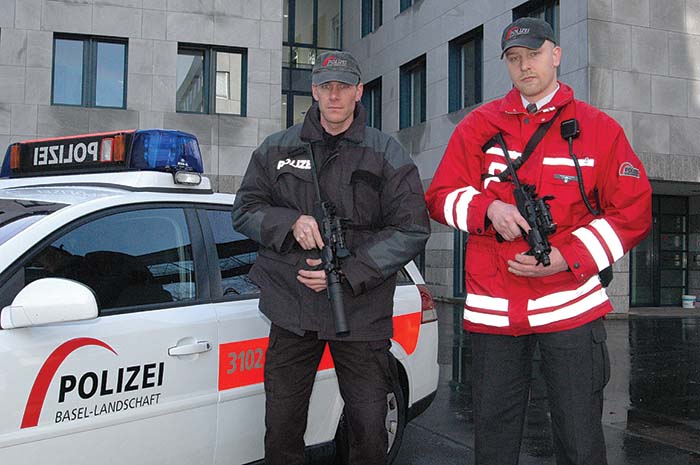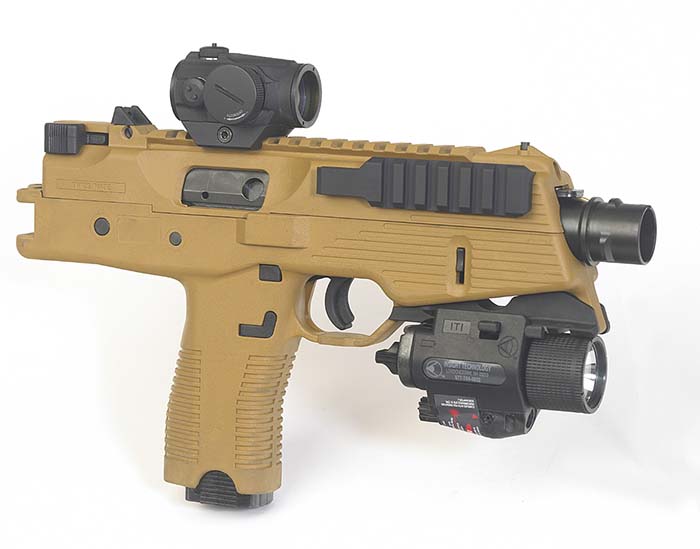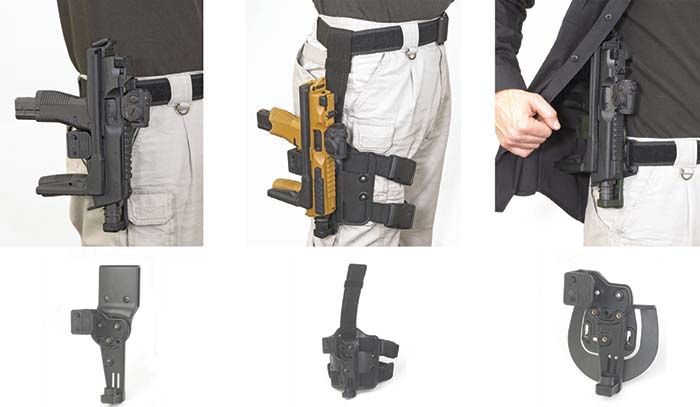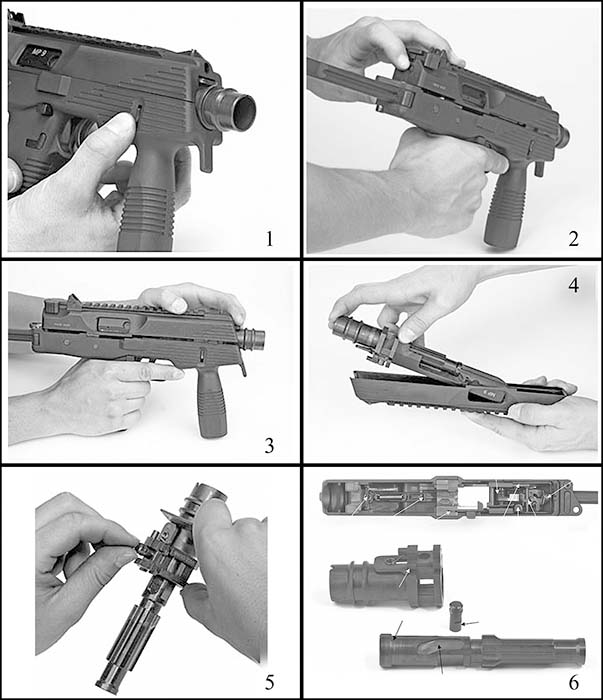By Mark Zimmerman
Many readers who read the Steyr’s Special Purpose Pistol (SSP) Article by James Creviston and Anthony Dee in SAR (Vol. 10, No. 6, 2007) have written or called and asked about the MP9, which is currently being advertised in SAR. The usual question is, “Is it the same gun?” The answer is both yes and no and in order to get to the bottom of this, Mark Zimmerman from B&T in Switzerland was asked to write about the gun to give us all a better idea of how the TMP became the MP9.

Every so often there are ideas or products that are introduced in the firearms industry that every observer agrees are quite good but for one reason or another just don’t make it to market or are unsuccessful. It could have been bad timing, bad marketing, a lack of resources or just bad management. The story of the MP9 is an interesting story about how a potentially good product that for all practical purposes was dead and was about to be buried, has now has been reborn for a second chance to serve law enforcement and military the world over.
Those who read the last article can guess the MP9 started life many years ago as the SPP/TMP submachine gun. From a commercial point of view it never really made it in the world market because it was never fully developed and poorly marketed. Another handicap with Steyr was the lack of a decent international network in which to plug in new professional products. The limited number of countries that are using the AUG rifle serves as a testimony to this fact.

In 2001, non-industry investors bought out Steyr. Like any new owner of any acquired company, they reviewed the profit and loss of each product and decided to drop the TMP. They did this because the volume of units sold did not justify keeping it in the product line. The fact that there were ways to revive and re-launch the product was of no interest to businessmen who wanted return on their investment as soon as possible. That is business.
Brügger & Thomet (B&T) had an ongoing relationship with Steyr on some other projects and understood the shortcomings of past TMP marketing and made the Steyr management an offer for all the drawings, licenses, spare parts and current inventory. The Steyr management thought this was a great deal because they were just going to destroy everything; and in late 2001 B&T acquired all the rights to the SPP/TMP worldwide.
Since then B&T has taken their time to improve what was already a pretty good little design. B&T made over 19 different engineering changes and added features to the gun and finally renamed it the MP9 for Machine Pistol 9 millimeter.
Some professional readers might already know of Brügger & Thomet as one of Europe’s best known manufacturers of firearm suppressors and upgrade accessories to many weapon systems mostly to law enforcement, NATO and NATO partner countries. They are also the OEM (Original Equipment Manufacturer) supplier to most of Europe’s weapon manufacturers that include, HK, SIG, Beretta, Swiss Arms, Walther and Glock. In 2002, B&T received an award from HK as being one of its most reliable suppliers. Out of a possible 100 they received 99.6. Germans, by the way, never give 100 to anyone.
Producing a submachine gun, however, is much different that making a suppressor but B&T has experience with this as well. B&T produced its own version of the MP5. Not just only in one version but in all versions to include the MP5SD. They have dropped this product all together in favor of the MP9.
When one picks up the MP9, the size and weight is what one first notices. It weighs only 1.3kg (2.87 lbs) which makes it the lightest 9mm submachine in the industry. Some may say the Glock 18 (709 grams/1.56 lbs) and the Beretta 93-R (1,170 grams/2.58 lbs) are lighter but these are not really submachine guns but just pistols with full automatic capability and are very difficult to control. The Glock does not even have a shoulder stock, which is necessary if required to fire accurately. For a better comparison, the MP5K for example is a bit over 2 kg (4.41 lbs) and the MP5PDW is 2.78 kg (6.13 lbs). The MP9 is almost half the weight as the MP5PDW. Another point that is a factor here is that the MP9 stays in battery when making a contact shot when the operator places the muzzle of the weapon right up against the target. This point was well illustrated during a presentation to an Asian country’s navy who were responsible for boarding suspect freighters. In the close quarters, the operator chose to use his pistol as opposed to the MP5 for clearing the ship and had to make a contact shot with a pirate with his pistol. The pistol went out of battery and couldn’t fire with the situation quickly becoming a wrestling match until the operator’s partner could shoot the pirate at point blank range.
The size of the MP9 with the stock closed is only 30.5 cm (12.01 in). There are smaller submachine guns in the world like the MAC10/11 and Vz61, but these are obsolete by either firing the 7.65 ACP cartridge or from an open bolt and thus are unsuitable for today’s professional users. An operator can even carry the MP9 comfortably under a normal suit jacket using the B&T carry holster which was designed like an IPSC rig and can be attached to the belt loop attachments made by Safariland, Uncle Mike’s or Blackhawk.

The MP9 also has a nice smooth design with no exposed moving parts to get hung up on clothes or equipment. This makes the weapon’s size and weight ideal for many different applications, including: VIP & close protection teams, military & police special forces, vehicle crews, helicopter & aircraft crews, commanders and officers, police patrol weapon, plain clothes and undercover surveillance teams.
Another big plus with this design is the polymer construction of the MP9. Polymer is impervious to rust which makes it suitable for marine and combat diver operations. To that effect, the entire outer envelope of the pistol is made of a synthetic material. Another thing about polymers that many people often overlook is the potential to mold the weapon in different colors to be mission specific for the operator. The MP9 takes maximum advantage of this feature and is available in Black, Coyote Tan, Green and Red.
The ergonomics (and safety for that matter) are greatly enhanced by the integrated forearm grips of the MP9 that keep the hand of the operator away from the muzzle. When combined with the integrated folding stock, it allows for a very stable firing position. The magazine well is in the handgrip of the MP9 and is a much faster and efficient way of reloading any weapon. This method of operation is known as the “hands-find-hands” design and is so much quicker a typical operator can reload the MP9 in about one-third the time it takes to reload an MP5.
When it comes to training, the MP9 is from the start, “Ready for the real world…” by having an optimized FX Training version available. In the past, there always seemed to be a schism between the industry’s ammunition and firearms manufacturers. This has almost always been the case with FX Training ammunition. Why should a gun producer R&D and produce a version of their weapon that will benefit a single ammunition manufacturer? This is the first time a firearm producer has developed an FX firing version from the very beginning of the development of the weapon. So many special units in the world have adopted the FX for force on force training it is a must to have a compatible system. From the very beginning, B&T cooperated directly with SNC Technologies in Canada so that their MP9FX works as well as any other kit in production. It is a dedicated unit produced in training blue for safety. With a FX unit, units can really train the way they plan to operate. This is impossible with all the other PDWs on the market today.
This brings up a problem with all the new PDWs and calibers that are promoted in the world. These are namely the 5.7mm from FN Herstal and the 4.6mm from Heckler & Koch. When their engineers developed these systems, the concept of force on force training was not addressed. Many units or agencies use Simunition but found they had to forgo their real world scenario training if they adopted the new caliber. This could be a reason why these new calibers have not been nearly as successful as the manufacturers would have liked because of this faux pas.
B&T also came up with a clever idea when it comes to training with the MP9 by producing a red, non-firing manipulation gun called the MP9R. This is a non-gun and, like the MP9FX, cannot be made to fire live ammunition. The MP9R is ideal for rehearsals, immediate action drills, weapon retention, defensive tactics training or any one of a number of ways when an instructor or an operator has to point the weapon perhaps in the direction of other persons, like when explaining a firing stance. Simply put, no one has ever been shot or killed with a red non-gun.
The magazines are translucent in color so the operator can visual cue how many rounds are remaining in the magazine. This could be critical under stress when making tactical reloads. Most operators, if they are honest with themselves, would find if difficult to count how many they have fired, especially when firing full automatic bursts. If for some reason the operator does not want these clear magazines, black ones are available. The extremely durable plastic material lends itself to many years of tough use. It can be easily disassembled for cleaning and is impervious to chemical and any cleaning fluids. The MP9 comes with two magazines: one 15-round magazine, and another 30-round magazine as standard. Other magazines are also available in 20 and 25-round capacities. Custom size magazines are available as well as magazines in unique colors; for example blue when using Simunition FX or CQT ammunition
The MP9 employs a rather ingenious delayed blowback, short recoil operation featuring a rotating barrel. At the moment of firing, the barrel is solidly locked to the telescoping bolt via eight locking lugs with both parts moving rearward for a short distance. The barrel is then suddenly stopped and rotated free of the bolt, after a brief delay caused by resistance from the opposing torque of the bullet’s rotation. The bolt continues its rearward travel alone, completing the cycle of extracting and ejecting the fired casing, recocking the internal hammer and disengaging the sear. At this point the bolt is stopped and then begins to move forward under pressure from the recoil spring, chambering a round from the magazine. As it slams shut, the bolt forces the barrel to rotate into the locked position, ready for the next shot. This helps to limit the recoil impulse, and to reduce the cyclic rate, which is 800-900 rounds/min. This firing system, while not requiring a gas system, is very reliable and will continue firing even while the weapon is fouled. The Mean Rounds Between Failure (MRBF) of the MP9 is over 5,000 whereas all the other submachine guns on the market are much lower. As a result of this method of operation, the MP9’s perceived recoil is much reduced as compared to other 9mm submachine guns. Thus, it is capable of delivering greater accuracy in automatic fire than other submachine guns. At five meters (16.40 ft) distance, a good operator using a good stance can fire a 30-round burst and keep all 30 rounds in a 5 cm (1.97 in) group.
The cocking handle of the MP9 is quite similar in design to that of the Colt M4 and is located at the rear of the upper receiver. This is another nice safety feature as it will keep the hands of the operator away from the muzzle; especially critical when under stress.
The MP9 has a round post for a front sight that is adjustable for elevation by turning it with a screwdriver. There is no need to have a special sight adjustment tool that no one seems to have when it comes time to adjusting the point of impact. The top of the upper receiver has a molded M1913 Picatinny rail that allows the mounting of a variety of optical sights. Other submachine guns on the market require a special mounting system for what is becoming a must these days. The MP9’s open sights, however, were found to be quite adequate for most of the uses that this gun is bound to encounter. These are a ghost ring type design but the ghost ring sights are backup sights. B&T believes that subguns need to have an optic and approached Aimpoint some four years ago with a proposal for a very small optic and an open purchase order for what was recently introduced as the Aimpoint Micro T-1. After much R&D, Aimpoint developed what was considered an ideal match for the MP9. The trigger mechanism gets overall high marks for safety and simplicity. All the operator needs to do is pull the trigger back to fire. This system is not too unlike the Glock trigger design. This trigger incorporates an automatic safety that prevents the hammer from falling unless the trigger is actually pulled and thus acts as a drop safety. For the TP9, there is also a manually activated cross bolt trigger safety that any left or right handed operator can fire.

Suppressor are important for a weapon like this for a variety of reasons such as command and control, firing at night with or without night vision devices because it effectively masks muzzle flash, which also masks the location of the operator. A suppressor will reduce recoil and adds ease and safety to training, enhances friend or foe recognition and even increases accuracy. Many readers saw the suppressors used in Afghanistan when clearing the caves near Tora Bora. If an operator fired his weapon without a suppressor in any enclosed area he will not be able to hear what orders were being given by the team leader.
A PDW Competitor?
When B&T came out with the MP9 the idea was to make a submachine gun for a niche market of close protection, law enforcement and special military use. One of the surprises to B&T was how several NATO countries requested samples of the MP9 to evaluate as a possible PDW in lieu of a weapon chambered for any of the new calibers such as 5.7mm and 4.6mm. It seems that more than a few countries are not convinced that the new calibers are the wave of the future. This seems to be based on lack of proven terminal ballistics, readily available 9mm ammunition (to include new high performance armor piercing 9mm) or probably, and most likely, the logistical problems with introducing a totally new caliber into the organization.
Another point is that the enemy has changed when the original requirement for an armor piercing capable PDW was written in the late 1980s. In those days, the cold war was still going strong and NATO planners were concerned about in the event of war with the Warsaw Pact armies disrupting NATO command and control, logistics and communications centers using Spetsnaz Commando or what the Soviets called “Diversionary” troops. These special operators would wear body armor that consisted of many layers of a textile ballistic material and even titanium plates. On April 1, 1991 the Warsaw Pact alliance officially disbanded and many former members applied for membership into NATO and the EU. For ten years planners vacillated trying to predict when and where the next war will be. September 11 answered that question and the current profile reveals that the present enemy does not wear a bullet proof vest but a bomb vest. If the bad guys do not wear body armor then the operator does not need armor piercing ammunition. If the operator does need armor piercing capability then there is 9mm AP rounds that can defeat 3A body armor at 50 meters. If you are going to engage a target beyond that distance the operator is much better off using a short barrel assault rifle. The sizes of assault rifles have come down. For example, an HK G36C, when in the folder position,is exactly 500mm (19.69 in) long. The length of the FN P90 is exactly 500mm long. There is no need for an operator to compromise on the terminal ballistics. If size is an issue, the MP9 is a good choice. If range is an issue then a short rifle is a good choice and the need for a PDW as we have come to believe it must be reevaluated.
Available in politically correct SF version
(TP9 US BATF classified as pistol)
For those readers who are unaware, the US firearms market is the “Holy Grail” for most of Europe’s manufacturers. It is a huge, single and dynamic market that represents the potential to make any manufacturer or product a household word if successful. It is safe to say that if Glock was not as successful as it was in the US their world position would be much different than it is today. Many of the well known manufacturers have wholly owned manufacturing facilities in the US. SIG, FN Herstal and Berretta are making weapons in the US and now HK has announced its plans to build a facility in South Carolina. Americans don’t seem to have prejudice for ‘Made in the USA’ over European made products in the firearms industry. Even the US military is using almost exclusively European designed or produced products. The Beretta 92 is called the M9, The FN MINIMI is called the M249 SAW, the MAG is called the M240B, the SIG 228 is called the M11 and even the current M16 is made by the FN Herstal factory in Columbia, SC. Colt, however, still has the M4 contract but FN won the SCAR contract for the US Special Operations Command.
The B&T/DSA Connection
In 2005, B&T entered into a relationship with DS Arms (maker of the SA-58 rifle, the only US made FAL) to develop a BATF approved tactical pistol version of the MP-9. DS Arms and B&T have worked together for the last 10 years, and B&T was able to create a BATF approved pistol version of the MP-9 that is legal for importation into the US. The new pistol was designated TP-9, short for Tactical Pistol, and was introduced at Shot Show 2007.
Based on the design, available ammunition, ergonomics, training possibilities and flexibility, any professional user would be well served by taking a closer look at this weapon. It is not for everyone, but depending on the mission it could be a good tool in completing the mission and keeping people safe in what is becoming a more and more unsafe world.
DS Arms is the exclusive US importer for B&T products and the TP-9 pistol. DSA carries most of the items in the B&T product line, and stocks B&T rail systems and tactical accessories. For a list of available products and pricing, as well as more info on the new TP-9 pistol, check out DSA’s website at www.dsarms.com. DSA also carries a host of B&T accessory items for the TP-9 pistol. DS Arms celebrated its 20th year anniversary in 2007.
If you are interested in purchasing a TP-9 pistol or accessory items, please have your dealer contact the following distributors: Ellett Brothers, RSR Group, Sports South, and Zanders Sporting Goods. Law Enforcement or agency sales inquiries should be made directly to DSA at (847) 277-7258.
| This article first appeared in Small Arms Review V11N3 (December 2007) |










